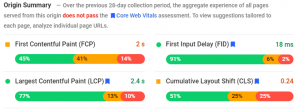Google’s page experience signals measure how users perceive the experience of interacting with a website page and contribute to its ongoing work to ensure people get the most helpful and enjoyable experiences from the web.
In May 2020, Google announced that these signals would be included in the Search ranking algorithm. As a result, in the past several months, Google’s seen a median 70% increase in the number of users engaging with Lighthouse and PageSpeed Insights, and many site owners using Search Console’s Core Web Vitals report to identify opportunities for improvement.
 More recently they announced that the new page experience signals – which will roll out in May 2021 – will combine ‘Core Web Vitals’ with its existing signals that already include mobile-friendliness, safe-browsing, HTTPS-security, and intrusive interstitial guidelines. The ‘Core Web Vitals’ comprise page loading, interactivity and visual stability.
More recently they announced that the new page experience signals – which will roll out in May 2021 – will combine ‘Core Web Vitals’ with its existing signals that already include mobile-friendliness, safe-browsing, HTTPS-security, and intrusive interstitial guidelines. The ‘Core Web Vitals’ comprise page loading, interactivity and visual stability.
Google also plans to test a visual indicator that highlights pages in search results that have great page experience and have met all of the page experience criteria. That will be a valuable indicator for Webmasters and it’ll also be helpful to users in choosing the search result that they want to visit. If Google’s testing of this is successful, it will launch in May 2021 as well.
To get ready for these changes, Google has released a variety of tools that publishers can use to start improving their page experience. The first step is doing a site-wide audit of a site’s pages to see where there is room for improvement with Search Console’s report for Core Web Vitals which gives an overview of how a site is doing and deep dives into issues.
Once opportunities have been identified, PageSpeed Insights and Lighthouse can provide further help on fixing any issues. This is also a useful article that lists all the vital tools.
Additionally, Accelerated Mobile Pages (AMP) is one of the easiest and cost-effective ways for publishers looking to achieve great page experience outcomes. AMPs are pages that take advantage of various technical approaches to prioritise speed and a faster experience for users by loading content almost instantaneously through Google’s cache.
Based on the analysis that Google has done, the majority of the AMP pages achieve great page experiences. AMP doesn’t directly affect organic search results though, but it does affect clicks, impressions, and user experience, which in turn affects SEO.
AMP publishers can view the recently launched AMP Page Experience Guide, an excellent diagnostic tool that provides developers with actionable advice.
Google continues to support AMP content in Search. If an AMP version of your content is published, Google Search will link to that cache-optimised AMP version to help optimise delivery to users. This cached delivery provides an excellent benefit to the user experience, as hardly anyone likes to wait more than a few seconds for mobile pages to load.
You can read more useful information about whether a WordPress site needs AMP.
Google Search’s mission is to help users find the most relevant and quality sites on the web. The goal with these updates is to highlight the best experiences and ensure that users can find the information they’re looking for.
Google plans to incorporate more page experience signals in the future and update them on a yearly basis. They hope that the provided tools and resources make it easier to create great websites, and thereby build a web ecosystem that users love.
If you want to know more about how website preparation for Google’s page experience signals could benefit your business please make contact.
